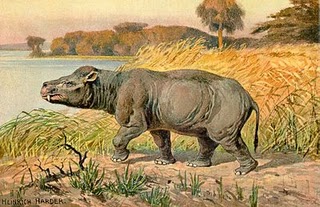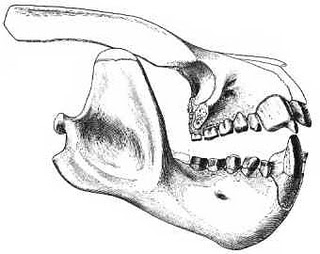
The pantodont Coryphodon, as reconstructed by Heinrich Harder. At the time of their existence, pantodonts were the largest herbivorous mammals. According to Wikipedia, Coryphodon reached about a metre in height and a weight of half a tonne, and also had the dubious distinction of having the smallest brain/body weight ratio of any mammal living or extinct.
Sixty-five million years ago last Tuesday, the mighty dinosaurs went extinct. Well, they didn't all go extinct, but that's how it's usually expressed because "the mighty dinosaurs went extinct except for a number of volant clades that actually continued to do pretty well for themselves, really" somehow just doesn't have quite the same ring to it. What remains a fact is that something pretty significant happened to the ecosystem at the end of the Cretaceous, leading to a major turnover that's usually represented as out with the dinosaurs, bring in the mammals. It is true that the mammals showed a significant rise in diversity during the Palaeocene, the time period immediately following the Cretaceous. However, few of the prominent mammalian groups of the time would be recognisable today.
Modern mammals are divided between monotreme, marsupials and placentals. It is the Placentalia (the group we ourselves belong to) that have been the most successful of the three groups overall, a success that has generally been attributed to their reproductive system of nourishing developing foetuses for longer periods and giving birth to more developed young*. When the fossil record is actually taken into account, Placentalia are a subset of a larger group called Eutheria. Eutherians are the total group containing placentals and all fossil mammals more closely related to placentals than marsupials, while placentals are the crown group of the eutherian lineages that have survived to the present.
*Whether this is really the secret of the placentals' success is more debatable than generally let on. For instance, it has been suggested that in highly unpredictable environments such as the arid centre of modern Australia, marsupials, with their lower nutrient commitment to developing offspring, may actually have the edge reproductive system-wise.

Skull of the taeniodont Psittacotherium, from Matthew (1937) via Paleocene Mammals. Late Palaeocene taeniodonts developed massively powerful jaws and cutting teeth. Psittacotherium was one of the most extreme forms, and at a weight of about 50 kg would have been comparable in size to a medium dog.
The eutherian and marsupial lineages had separated from each other by the early Cretaceous, but the question of when the modern placentals arose has been a hotly debated topic. While a number of Cretaceous lineages have been suggested to belong to the Cretaceous crown group - Zhelestidae as relatives of the ungulates (hoofed mammals), while Zalambdalestidae were close to rodents and lagomorphs (Archibald et al., 2001) - recent analyses have placed these taxa outside the placental crown, and the fairly comprehensive analysis by Wible et al. (2007) suggested that none of the fossil eutherians known from the Cretaceous are placentals. This stands in fairly stark contrast to molecular dating studies, which are fairly unanimous in suggesting that the modern placental orders diverged from each other during the Cretaceous. Either the molecular dating is all wrong for some reason, or the placentals were around in the Cretaceous and we just haven't found them yet.
Still, whether it was the ancestors of the placentals or a number of lineages that survived the end of the Cretaceous, the fossil evidence indicates at least four eutherian lineages survived into the Palaeocene. The Cimolestidae and Leptictidae, families present in both the Cretaceous and the Palaeocene, were placed by Wible et al. (2007) outside the placentals, while the Taeniodonta, a eutherian lineage of unknown relationships, was represented in the late Cretaceous by the species Schowalteria clemensi (Fox & Naylor, 2003). Whether the various other lineages known from the Palaeocene diverged from these lines after the end of the Cretaceous or also survived from earlier times is a decidedly open question.
As already indicated, few of the Palaeocene eutherians can be related directly to modern placental orders. Instead, the Palaeocene was the time of a number of lineages that are no longer with use - herbivores such as the pantodonts and dinocerates, small insectivores such as apatemyids and leptictids, carnivores such as creodonts and arctocyonids. Martin Jehle's Paleocene Mammals website has detailed coverage of many such groups. Palaeocene mammals were also quite distinct from modern taxa in the overall range of morphologies - for want of a better way to put it, Palaeocene eutherians tend to look - well - lumpier than modern species. The broad grasslands that currently dominate the terrestrial part of the world were not yet in existence, and the Palaeocene was a time of forests. As a result, the grassland-adapted cursorial morphologies like modern horses and antelope were also absent, and the low-slung waddler was king.

The early dinocerate Prodinoceras xinjiangensis, as reconstructed by Stanton Fink.
So how did these Palaeocene waddlers relate to the modern taxa evolutionarily? The only answer we can really give at this point is, who knows? The relationships between the Palaeocene and the modern eutherian orders remain almost completely unknown, and those few connections that have been accepted in the past have been profoundly shaken. For instance, many of the Palaeocene families have been included in the 'condylarths', a heterogeneous assemblage believed to be related to the modern ungulates. However, it has become well established in recent years that the ungulates represent at least three separate lineages, with the artiodactyls (even-toed hoofed mammals), perissodactyls (horses and rhinoceros) and paenungulates (elephants and hyraxes) all arising from separate ancestors in the placental tree. Which condylarths are related to which modern ungulates? For that matter, are they related to any of them? If the ungulate morphology arose at least three times in lineages that survived to the present, why should we assume that it couldn't have also appeared independently in extinct lineages? Similar issues surround Palaeocene 'insectivoran' families, whose association with possibly polyphyletic modern insectivorans should be regarded as doubtful.
In light of the findings of Wible et al. (2007), we might even doubt whether many of the Palaeocene eutherians even represent placentals. The classification of McKenna and Bell (1997) united many early eutherians such as Cimolestidae, Pantodonta and Taeniodonta (as well as the modern pangolins) into a group called Cimolesta, which was then included in the Ferae with creodonts and Carnivora. While pangolins may indeed be related to carnivorans, Cimolestidae, as referred to above, are not even placentals. What then becomes of the rest of the "Cimolesta"? Are they also stem-eutherians like Cimolestidae, or are they true placentals?
Such questions are not mere curiosities - the answer could have significant effects on our understanding of Palaeocene ecology. At least some stem eutherians such as the Zalambdalestidae possessed epipubes, bones that support the pouch in marsupials but are absent from placentals (Kielan-Jaworowska, 1975). Because of the restrictions epipubes place on the expansion of the abdomen, they may be incompatible with a placental reproductive system. As a result, we cannot assume that stem eutherians bore well-developed young like modern placentals do. Did pantodonts walk around with pouches slung from their bellies?
REFERENCES
Archibald, J. D., A. O. Averianov & E. G. Ekdale. 2001. Late Cretaceous relatives of rabbits, rodents, and other extant eutherian mammals. Nature 414: 62-65.
Fox, R. C., & B. G. Naylor. 2003. A Late Cretaceous taeniodont (Eutheria, Mammalia) from Alberta, Canada. Neues Jahrbuch für Geologie und Paläontologie – Abhandlungen 229 (3): 393-420.
Kielan-Jaworowska, Z. 1975. Possible occurrence of marsupial bones in Cretaceous eutherian mammals. Nature 255: 698-699.
Wible, J. R., G. W. Rougier, M. J. Novacek & R. J. Asher. 2007. Cretaceous eutherians and Laurasian origin for placental mammals near the K/T boundary. Nature 447: 1003-1006.